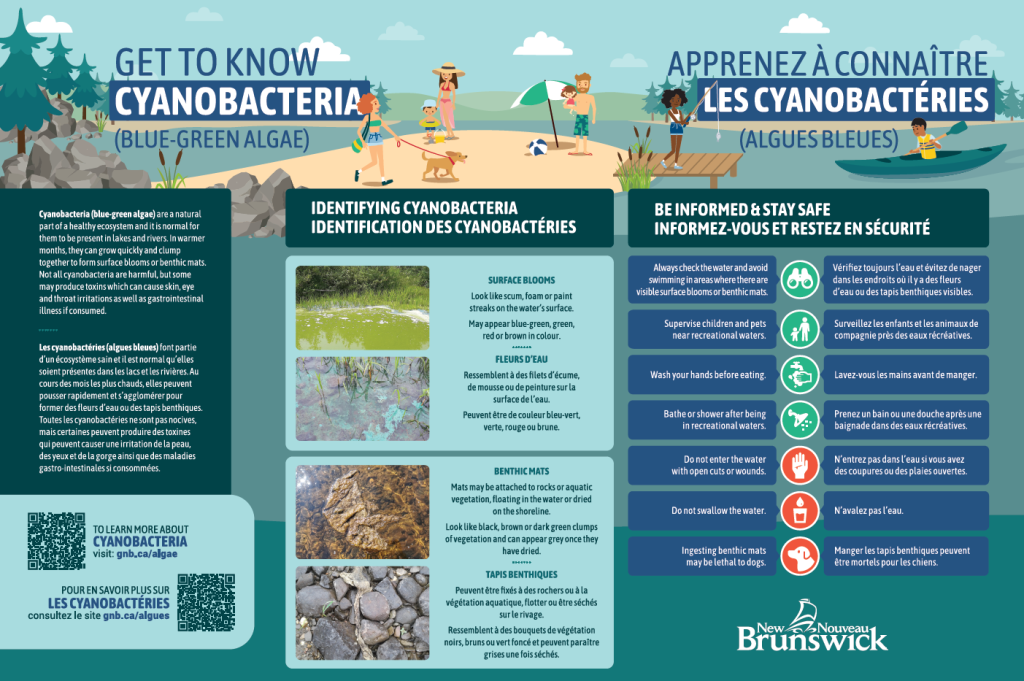PUBLIC NOTICE – Blue Green Algae – Be informed and stay safe
Sussex has been advised by the New Brunswick Department of Health that the section of Trout Creek between Leonard Drive and Maple Avenue within the municipal boundaries of Sussex has shown signs of Cyanobacteria. Cyanobacteria can produce toxins, which may cause skin, eye and throat irritations. More serious health effects such as gastrointestinal illness can occur if toxins are consumed.

Being active and enjoying the outdoors has many benefits for your physical and mental well-being. Public Health New Brunswick encourages you to be active and enjoy the outdoors, but to be alert and take precautions. There are always things you can do to protect yourself while enjoying recreational waters.
Public Health New Brunswick recommends the following safety advice:
• Always supervise children and pets near recreational water. They may be more at risk of becoming ill.
• Always check the water and avoid swimming in areas where there are visible surface blooms, scum or benthic mats are present.
• Do not enter the water with open cuts or wounds.
• Always wash your hands before eating.
• Do not use water from areas with cyanobacteria blooms for washing, drinking or cooking. Boiling the water will not remove toxins. Always obtain drinking water from a clean and safe source.
• Fish caught from water where cyanobacteria blooms are present should have all their organs removed and be rinsed well with clean drinking water before being cooked and eaten.
• Even if no cyanobacteria blooms are present, it is recommended you shower with clean water after being in recreational waters.
Toxins can sometimes remain in the water for several weeks after surface blooms are no longer visible. As a precaution, it is recommended that recreational water use be avoided in areas where surface blooms are present.
If you begin experiencing symptoms or health effects you should seek medical advice from a health-care provider.
Protecting your pets
Why are cyanobacteria (blue-green algae) dangerous for dogs and other animals?
Some cyanobacteria produce toxins that could be harmful to a dog’s liver and brain. Dogs are attracted to the odour, and if ingested, they may:
• Vomit and be sick
• Have a seizure
• Experience breathing difficulties
• Have diarrhea
• Collapse and become unconscious
• Die
Call a veterinarian right away if you suspect cyanobacteria poisoning.
How can I avoid cyanobacteria?
• Always check the water and shoreline for blooms and mats.
• Do not let dogs drink or swim in water where visible blooms or mats are present.
• Do not let dogs eat benthic mats or vegetation floating in the water or along the shore.
• On hot days, consider walking your dog in the morning or evening.
• Always take fresh water on walks for you and your dog.
Cyanobacteria is the proper name for blue-green algae, because these organisms are actually bacteria and not algae at all! Cyanobacteria were the earliest known forms of life on earth. When first discovered, cyanobacteria looked similar to algae and can sometimes appear blue-green in colour – which is why the term blue-green algae was used.
They are a natural part of our environment and water ecosystems, and can be found in many ponds, lakes, rivers, and wetlands in New Brunswick. Blooms usually occur when temperatures get warmer, typically in the late spring and early summer sometimes appearing quickly or overnight. They are not normally visible, but under certain conditions (warm, slow moving, shallow water and lots of sunlight) and when there is lots of food (nutrients such as phosphorus and nitrogen), they can grow quickly and clump together to form surface blooms or benthic mats.
Some types of cyanobacteria can produce toxins that are harmful to humans and animals. Because of this, public health advisories may be issued. Advisories help recreational water users make informed decisions on water use in the affected area. They also help remind users to check the water for visible surface blooms, scum, and benthic mats, which pose the most risk. Since conditions may change in a matter of hours, it is important to be aware of local water conditions. Individuals should always check the water and scan the shoreline before engaging in recreational water activities such as swimming, wading, canoeing and paddle boarding, etc. Avoid swimming in areas with visible surface blooms or benthic mats.
